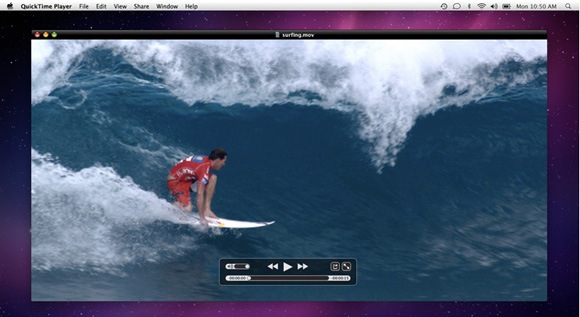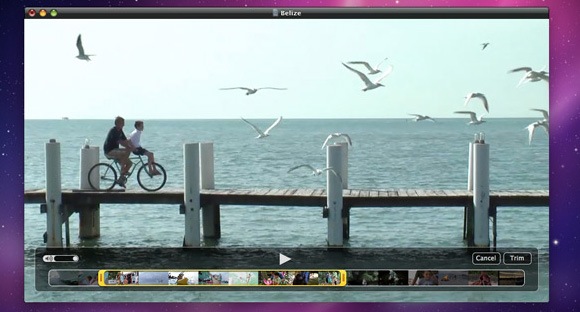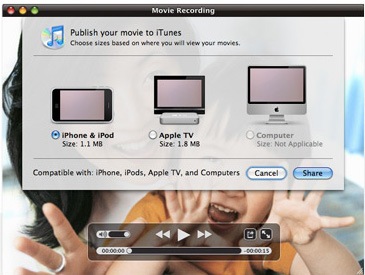Okay, having gotten my rant about Apple’s extreme level of secrecy out of the way (I’m standing by that), we can at least talk about what Apple is saying about QuickTime X, cutting through the marketing as best as possible.
We’ve known for some time that QuickTime X would be a ground-up rewrite – one badly needed. That could have some implications for compatibility, though, which is something to watch. The details are sketchy at this point, but here’s what’s possible to say:
- X is more integrated with Core technologies. Apple promises that QuickTime X will build on Core Audio, Core Video, and Core Animation. Some of that is to say that the long-in-the-tooth player application itself will work with those technologies more than the underlying QuickTime framework.
- There’s a new player. It’s about time: QuickTime Player gets an update. The nicest feature here is the slick trimming interface Apple has added. A lot of us use QT Player for quick edits and other tasks, so this is definitely welcome.
- There’s no more “Pro.” Finally, you don’t have to spend thirty bucks just to make QuickTime Player a useful tool. In fact, you’ll get all of Snow Leopard for that price (if you already have Leopard).
- Playback is more efficient. Here’s the part that could be most useful to live visual apps. Playback is now more “optimized” and makes use of the GPU for scaling, display, and hardware-accelerated H.264 decoding. Decoding, interestingly, uses the NVIDIA 9400M integrated chip. Most live visual apps already use the GPU for scaling and display, but under-the-hood performance tweaks and decoding features should be good news.
- HTTP video streaming. You can now stream video live over HTTP, which means you can use a standard Web server like Apache instead of a specialized video server, and you don’t have to open special ports on your firewall.
- ColorSync for maintaining color profiles on the computer and on mobile devices (well, provided those devices are also made by Apple).
- Built-in screen recording: You can now create quick screencasts using QuickTime player – groovy. (The Mac is, unquestionably, the easiest platform out there when it comes to making screencasts. Ask any tech journalist or educator.)
- Quick capture: Capture is improved in QT Player for quick recording – always a handy thing to have.
- Performance improvements. QuickTime X promises to take advantage of Grand Central Dispatch, the new Apple threading technology, and 64-bit computing for better performance.
Of course, what’s missing in all of this is any mention of how this works for developers, how things like color profiles might be interoperable on non-Apple platforms, or what happens to QuickTime for Windows. In typical Apple fashion, this is all about what benefits the Mac and what’s built on the Mac’s own technologies. That’s not necessarily a bad thing – in fact, Microsoft, you are still working on DirectShow, right (cough)? But the more these platforms become proprietary and specific, the more painfully obvious the need for better cross-platform frameworks becomes. Nor does everything always have to be tied up with the OS. Apple’s own emphasis – portability to mobile devices, GPU-native processing – in fact speaks directly to cross-platform, OS-agnostic issues.
Already, many interesting commercial and open source applications are starting to build on cross-platform frameworks like ffmpeg/GStreamer. To call these developer-friendly, though, would be an exaggeration. Part of the problem is that the dark cloud of patent confusion, fueled by the US’ antiquated intellectual property law, casts a shadow over more widespread use of such frameworks.
I think there’s value in creating OS-specific tools, and it certainly makes sense given Apple’s business model. But because we rely on these foundations for art, and because development often extends beyond devices with Apple logos on them, the alternatives are important. Apple had at one point aspired to build across platforms – but the legacy of QuickTime never became that, which is part of why it missed out on Web deployment to Flash and why it could miss out again on emerging trends in development.
Apple is focused – perhaps fairly so – on their ecosystem. But when you see images like the mobile export option, don’t you wonder a little bit about what would benefit your ecosystem?
At least the good news is, my sources suggest Snow Leopard should be a really nice visualist upgrade for Mac fans – and while there’s nothing I can get on the record, Quartz Composer should continue to develop, too. Stay tuned for fall, the official release, and compatibility info.
More information:
http://www.apple.com/macosx/technology/#quicktimex
http://www.apple.com/macosx/refinements/enhancements-refinements.html


